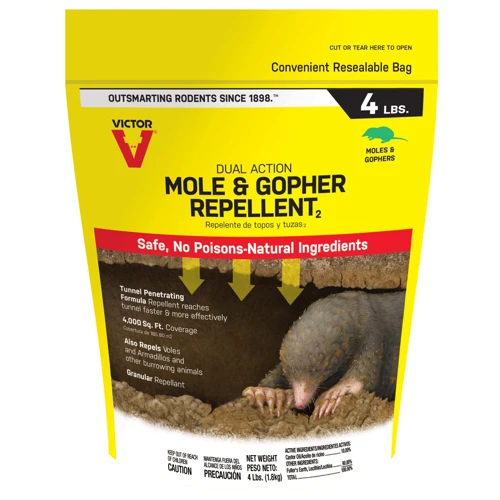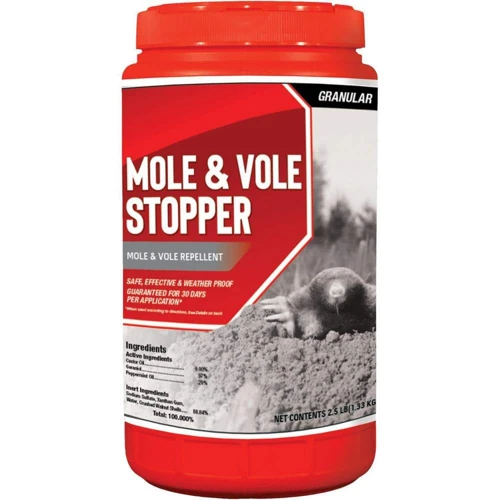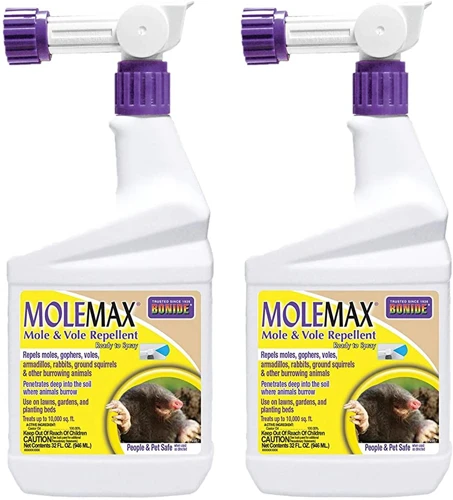Have you ever found your lawn or garden riddled with unsightly mole tunnels? If so, you’re not alone. Many homeowners experience this frustrating problem and are looking for effective solutions. Chemical mole repellents can be a helpful tool in deterring moles from damaging your property, but with so many different active ingredients available, it can be challenging to understand which one is right for you. In this article, we will explore the three main types of active ingredients in chemical mole repellents, their effectiveness, and duration, as well as important factors to consider when choosing the best product for your needs. Let’s dive in!
The Three Main Types of Active Ingredients in Chemical Mole Repellents

Many people struggle with mole infestations in their lawns and gardens. Fortunately, there are several chemical mole repellents available that can help keep these pesky critters at bay. The effectiveness of these repellents depends on their active ingredients. There are three main types of active ingredients that are commonly used in chemical mole repellents: castor oil-based, peppermint oil-based, and aluminum ammonium sulfate-based. Each of these active ingredients works in a different way to repel moles. To understand how they work and determine which one might be best for your situation, it’s important to take a closer look at each type of repellent. For more information on mole repellents in general, check out our previous article on the science behind mole repellents.
Castsor Oil-Based Repellents
Castor oil-based repellents are one of the most popular options when it comes to mole control. A **primary** reason for this is that the active ingredient, castor oil, is a natural repellent. These repellents work by making the moles’ environment uncomfortable and unpleasant, which leads them to leave the area. Castor oil-based repellents come in different forms, such as granules or sprays, making it easy to apply them in gardens, lawns, and other areas where mole infestations occur.
One way castor oil-based repellents work is by **disrupting** the moles’ sense of smell. Moles have highly sensitive olfactory organs, which they use to navigate, seek out food, and detect predators in the soil. Castor oil-based repellents have a strong and unpleasant odor that confuses the moles’ sense of smell, making it difficult for them to locate their food sources.
Another way castor oil-based repellents work is by **creating** an unpleasant environment for moles. Castor oil is known to contain two compounds, ricinoleic acid and undecylenic acid, that have toxic effects on the moles’ digestive and nervous systems. The undecylenic acid component becomes active when the castor oil is exposed to soil, creating an odor and taste that moles find repulsive.
It’s worth noting that while castor oil-based repellents are effective, they require regular applications to maintain their potency. The **effectiveness** of these repellents usually lasts for a couple of weeks, depending on the weather and the application method. Homeowners may need to reapply regularly to achieve their desired results.
One advantage of castor oil-based repellents is that they are safe for the environment and non-toxic to humans and pets. They provide an eco-friendly alternative to chemical mole repellents that contain harmful substances, which can pose health and environmental hazards. Additionally, castor oil-based repellents are relatively easy to apply and require no special equipment or expertise.
If you’re interested in learning more about the effectiveness and duration of different types of active ingredients on moles, check out our article on mole control options. You may also want to explore other natural mole repellent options that are equally effective, such as peppermint oil-based repellents, as discussed in our article on DIY mole repellents. If you’re weighing the pros and cons of chemical mole repellents, our article on pros and cons may help you make an informed decision. Finally, if you’re interested in learning more about environmentally-friendly chemical mole repellents, check out our article on enviro-chem mole repellents.
Peppermint Oil-Based Repellents
Peppermint oil-based repellents are another effective option in the fight against mole infestations. The active ingredient in these repellents is, as the name suggests, peppermint oil. Peppermint oil, which is derived from peppermint plants, is a natural deterrent for moles and many other types of pests.
Peppermint oil works by overwhelming the mole’s sense of smell. When moles detect too much peppermint odor, they become disoriented and are less likely to explore the area. This effect is particularly useful for homeowners who want to keep moles out of their gardens as they will not want to damage plants in such an overwhelming environment.
One of the advantages of using peppermint oil-based repellents is that they are entirely natural and nontoxic, making them a safe option for use in home gardens. These repellents are also free from harmful chemicals, which is vital if a chemical-free environment is your goal. They are an excellent option for those who prefer DIY solutions as it is easy to create a peppermint oil-based repellent at home with relatively cheap ingredients. You can mix a few drops with water and then spray the solution around your garden, taking care to reapply every few days as needed.
However, peppermint oil-based repellents don’t typically last as long as other repellents, like those made with castor oil. While very effective and appealing, the odor of peppermint oil can fade relatively quickly, and its effectiveness against moles can diminish. As the repellents’ duration is limited, they might not be the best choice for those who want to set and forget about mole control options. But if you have a relatively small garden and are willing to reapply the repellent frequently, they can be an effective solution.
Peppermint oil-based repellents can be a great option for homeowners looking for an effective and natural solution for repelling moles. Although their effectiveness may be limited, DIY enthusiasts can easily make their own concoctions, use it to repel pests and offer their properties the benefit of a natural repellent method. However, if you’re not a DIY enthusiast and are looking for longer-lasting repellents, you might want to look for alternative options. To learn more about other mole control options, check out our page on mole control options or for homemade remedies, our page on DIY mole repellents.
Aluminum Ammonium Sulfate-Based Repellents
One of the three main types of active ingredients in chemical mole repellents is aluminum ammonium sulfate-based repellents. This ingredient works differently from the other two types.
- Unlike castor and peppermint oil-based repellents, aluminum ammonium sulfate doesn’t disrupt the mole’s sense of smell or overwhelm it with a strong odor.
- Instead, it creates an irritating environment for the mole.
- When the repellent is applied, it forms a barrier around the treated area. If the mole comes in contact with the repellent, it may experience an unpleasant feeling that causes it to avoid that area.
- The sensation created by aluminum ammonium sulfate can also prevent the mole from feeding normally. This can eventually lead the mole to leave the area in search of a more comfortable feeding ground.
When considering the effectiveness of aluminum ammonium sulfate-based repellents, it’s important to note that they may have a shorter lifespan than castor or peppermint oil-based repellents. While they are effective at first, the repellent can be washed away quickly in wet conditions or may evaporate over time. Additionally, they may require more frequent reapplication than the other types of repellents.
When choosing an active ingredient for your mole repellent, it’s important to consider various factors such as the environmental impact, property and garden safety, and application method and convenience. It may be necessary to experiment with different types of repellents or combine several to find the most effective solution for your specific needs.
How Different Types of Active Ingredients Repel Moles

Now that we have covered the three main types of active ingredients found in chemical mole repellents, it’s important to understand how each of these ingredients actually repels moles. Each active ingredient works in a unique way to create an environment that is unpleasant or irritating to these burrowing animals. By understanding the specific methods of each ingredient, homeowners can choose the most effective solution for their particular mole problem. Let’s dive into the details on how castor oil, peppermint oil, and aluminum ammonium sulfate work to ward off these pesky critters.
Castor Oil-Based Repellents
Castor oil-based repellents are one of the three main types of active ingredients found in chemical mole repellents. They are made from natural castor oil that has been extracted from castor beans. Below are some of the ways in which castor oil-based repellents work to repel moles:
- Disrupts their sense of smell: Castor oil contains naturally occurring compounds that have an unpleasant odor to moles. When these compounds are released in the soil, moles’ sense of smell is disrupted, making it difficult for them to locate food and shelter.
- Creates an unpleasant environment: The unpleasant smell of castor oil-based repellents creates an unfavorable environment for moles. They will begin to feel uncomfortable and try to leave the area in search of a more suitable habitat.
It is important to note that castor oil-based repellents may not provide an immediate solution to mole infestations. It takes time for the repellent to be absorbed by the soil, and for moles to realize that the area is no longer conducive for their survival. Additionally, the effectiveness and duration of castor oil-based repellents may vary depending on factors such as soil type, application method, and weather conditions.
When considering the use of a castor oil-based repellent, homeowners should also take into account any potential environmental impact and safety concerns. Castor oil is a natural, biodegradable substance and is generally considered safe for use around pets and humans. However, it is important to follow application instructions carefully and keep the repellent away from any water sources.
Castor oil-based repellents can be an effective and environmentally-friendly option for repelling moles from your property.
Disrupts Their Sense of Smell
Castor oil-based repellents are known to be effective against moles, and one of the ways in which they work is by disrupting their sense of smell. This is due to the presence of a chemical called “ricinoleic acid” in castor oil, which is known to be an irritant to moles. Ricinoleic acid causes a burning sensation in the nose of moles, which makes them avoid the area.
In addition to being an irritant, ricinoleic acid also has a pungent smell that moles find unpleasant. The strong odor of the castor oil-based repellent creates an environment that makes it difficult for moles to navigate, and they will eventually avoid the area.
The presence of castor oil in the soil also makes it difficult for the moles to find their food, as it masks the scent of their prey. As a result, moles will find it much harder to locate their food source and will either move elsewhere or die of starvation.
The disruption of the mole’s sense of smell is an effective way to control mole activity in an area. It is a safe and natural way to keep moles out of your property without causing harm to these small creatures. However, it is important to note that it may take time for the moles to completely leave the area, and repeated applications of castor oil-based repellent may be necessary to ensure full effectiveness.
Creates an Unpleasant Environment
One way Castor Oil-Based Repellents work to repel moles is by creating an unpleasant environment for them. This is accomplished through various means, such as changing the soil chemistry and texture, upsetting the mole’s food supply, and creating a strong odor that the mole finds unpleasant.
Studies suggest that when mole repellents are applied to the soil, the repellent can make the soil unappealing to moles. This is usually done through altering the soil’s pH level or changing its texture. Moles prefer to live in a soil type that is loose and moist. When Castor oil-based repellents are applied to the soil, it can make the soil less hospitable to the mole, causing them to seek out a more suitable environment.
Castor oil-based repellents also contain strong odor that is unpleasant to moles. This is because the components of the repellent have a scent that is noxious to the mole’s sense of smell. The scent can disrupt the mole’s ability to track down its food or find its way around its territory.
Another unpleasant effect of Castor Oil-Based Repellents is that it can upset the mole’s food supply. When the repellent is applied to the soil, it can negatively impact the earthworm population, making it more difficult for the mole to find a food source. This can lead to the mole seeking out other areas to forage, away from the treated area.
It’s important to note that while Castor Oil-Based Repellents can be effective at repelling moles, they are not always 100% foolproof. Factors such as rainfall, soil type, and the amount of foot traffic the area receives can all impact the effectiveness of the repellent. However, when used correctly and in combination with other methods, such as traps and physical deterrents, Castor Oil-Based Repellents can be a powerful tool in the struggle against mole infestations.
Here is a table summarizing the ways Castor Oil-Based Repellents create an unpleasant environment for moles:
| Method | Effect on Moles |
|---|---|
| Altering Soil pH or Texture | Makes soil less hospitable to moles |
| Strong Odor | Disrupts mole’s sense of smell |
| Upsetting Food Supply | Makes it difficult for moles to find food |
Peppermint Oil-Based Repellents
Peppermint oil-based repellents are another popular type of chemical mole repellent. Peppermint has a strong smell that can overwhelm the moles’ sense of smell, making it difficult for them to find their way and locate their food sources.
Overwhelms Their Sense of Smell: Peppermint oil is known for its strong odor which can help to overwhelm the moles’ sense of smell. As a result, it can make it hard for them to find their prey, making it difficult for them to survive.
Peppermint oil-based repellents work differently from castor oil repellents. While castor oil makes the soil environment unpleasant for moles, peppermint oil simply disrupts their sense of smell. This can be done through several ways, including sprays and granules that are applied to the soil surface.
One of the benefits of using peppermint oil-based repellents is that they are natural and environmentally friendly. They are made from natural ingredients and do not contain any harmful chemicals that could damage the environment. Additionally, they are safe to use around pets and children.
However, peppermint oil-based repellents may not be as effective as castor oil repellents, especially in cases where the infestation is severe. They also do not have a long duration of effectiveness and may need to be reapplied more frequently.
Effectiveness: Peppermint oil-based repellents may not be as effective as castor oil repellents, especially in cases where the infestation is severe.
Duration: Peppermint oil-based repellents do not have a long duration of effectiveness and may need to be reapplied more frequently than other types of repellents.
When considering different types of active ingredients for mole repellents, it is important to consider their effectiveness, duration, environmental impact, and safety for use around pets and children. By carefully considering these factors, homeowners can choose the most effective and safe option for their specific needs.
| Peppermint Oil-Based Repellents |
|---|
| Effective in overwhelming the moles’ sense of smell |
| Natural and environmentally friendly |
| Safe for use around pets and children |
| May not be as effective as castor oil-based repellents |
| May need to be reapplied more frequently |
Overwhelms Their Sense of Smell
Peppermint oil-based mole repellents are designed to overwhelm the moles’ sense of smell with a strong and pleasant scent. The strong mint aroma is so powerful that it can mask the scent of the moles’ favorite food, earthworms, thereby causing them to lose their appetite and leave the area. This is especially effective when the repellent is applied near the mole’s main tunnel entrances.
The strong peppermint scent also confuses the moles’ sense of direction, making it difficult for them to navigate their way around their territory. As a result, they may become disoriented and leave the area altogether.
Peppermint oil-based mole repellents contain high concentrations of menthol and other active compounds that are known to have a strong scent that moles find unpleasant. These compounds work by stimulating the receptors in the moles’ nasal cavities, which in turn triggers a response in their nervous system that makes them want to avoid the area.
The overwhelming scent of peppermint oil-based mole repellents can be an effective way to deter moles from invading your lawn and garden. However, it is important to note that the effectiveness of this type of repellent may vary depending on the severity of your mole problem and the type of soil in your area.
Aluminum Ammonium Sulfate-Based Repellents
When it comes to aluminum ammonium sulfate-based mole repellents, it is important to note that they work differently from the castor oil and peppermint oil-based repellents.
According to studies, aluminum ammonium sulfate-based repellents work by creating an irritating environment that the moles find uncomfortable. This irritation is caused by the repellant’s acidic qualities, which can cause burning and stinging sensations on the skin and eyes of the moles.
To help you better understand its effectiveness and duration, here’s a breakdown in the form of an HTML table:
| Effectiveness | Duration | |
|---|---|---|
| Aluminum Ammonium Sulfate-Based Repellents | Effective in the short term, but may not provide long-lasting protection. | May need to be reapplied frequently to maintain repellency. |
When deciding on an active ingredient for your mole repellent, it is important to consider the potential environmental impact of the product, as well as the safety for use around your property and garden. Additionally, it is important to choose an application method that is convenient for you.
Creates an Irritating Environment
Aluminum ammonium sulfate-based repellents are effective in repelling moles by creating an irritating environment. This active ingredient is known for its ability to disrupt the natural pH levels of the soil, making it highly acidic. The high acidity levels irritate the mole’s skin and make it uncomfortable for them to dig tunnels in the treated area. The mole is forced to move away to other areas where the conditions are more favorable.
Here are some key points to consider about how aluminum ammonium sulfate-based repellents create an irritating environment:
- Disrupts pH levels: The high acidity levels, caused by the aluminum ammonium sulfate active ingredient, makes the soil inhospitable for moles
- Irritates skin: Moles have sensitive skin, and the high acidity caused by the active ingredient can cause burning and irritation when they come into contact with the soil, making it difficult for them to burrow
- Makes area less attractive: Moles are attracted to soil with a neutral pH, and when this balance is thrown off, they are less likely to tunnel in the area treated with the repellent.
Although aluminum ammonium sulfate-based repellents can be effective in repelling moles, it is essential to use them with caution. High levels of acidity can impact other plants and creatures in the soil. On the other hand, environmentally-friendly repellents can be an option to avoid negative effects. To prevent harm, make sure to follow the manufacturer’s recommended application guidelines and consult a professional if you have any concerns about the use of this active ingredient.
Effectiveness and Duration of Different Active Ingredients on Moles

When it comes to chemical mole repellents, understanding the effectiveness and duration of each active ingredient is crucial in choosing the right solution for your needs. Different active ingredients have different ways of repelling moles, and their effectiveness and duration can vary as well. In this section, we will dive into the specific effectiveness and duration of castor oil-based, peppermint oil-based, and aluminum ammonium sulfate-based repellents. By the end of this section, you will have a better understanding of which active ingredient may work best in your particular situation.
Castor Oil-Based Repellents
Castor oil-based repellents are one popular option for those seeking to repel moles from their lawns and gardens. These repellents work in a couple of ways.
Sense of Smell: Moles rely heavily on their sense of smell to navigate their environment and locate food. Castor oil-based repellents disrupt this sense of smell, making it difficult for moles to locate their prey, and providing a general feeling of discomfort.
Unpleasant Environment: In addition to unsettling their sense of smell, castor oil-based repellents create an unpleasant environment for moles. Moles prefer moist soil, so when the repellent is applied to the soil, it makes the environment drier and less hospitable for moles.
There are some factors to consider when using castor oil-based repellents.
- Effectiveness: While castor oil-based repellents are generally effective in repelling moles, results may vary depending on the severity of infestation and the size of the property. It may take several applications before the desired effect is achieved.
- Duration: Castor oil-based repellents typically last for several weeks, which means reapplication is necessary to maintain effectiveness.
- Environmental Impact: Castor oil-based repellents are generally non-toxic and safe for the environment. However, it is important to use these repellents as directed to avoid unintended consequences.
- Property and Garden Safety: Castor oil-based repellents are generally safe for use around children and pets. However, it is still important to read and follow the manufacturer’s instructions carefully.
- Application Method and Convenience: Castor oil-based repellents can be applied in a variety of ways, including granules, sprays, and concentrated formulas. Depending on the size of the property and personal preference, one method may be more convenient than others.
Castor oil-based repellents are a safe and effective option for those searching for a mole repellent. While they may take some time and effort to achieve optimal results, with proper use and regular reapplication, homeowners can enjoy a mole-free lawn and garden.
Effectiveness
When considering the effectiveness of each active ingredient in chemical mole repellents, there are a few key points to keep in mind:
- Castor Oil-Based Repellents: Castor oil-based repellents have been used for decades and are a popular choice among homeowners. While they may not completely eradicate moles from your yard, they can certainly help reduce their presence.
- Peppermint Oil-Based Repellents: Peppermint oil-based repellents are also popular among homeowners due to their strong scent and effectiveness. They can be a good option for those who prefer a natural solution, but it’s important to note that they may not be as effective as castor oil-based repellents.
- Aluminum Ammonium Sulfate-Based Repellents: Aluminum ammonium sulfate-based repellents are the newest addition to the market and are quickly gaining popularity. While they may not be as well-known as the other two types of repellents, they have been proven to be just as effective in deterring moles from your yard.
It’s important to note that the effectiveness of each active ingredient can vary depending on the individual situation. Factors such as the severity of the mole infestation, the size of your yard, and the application method can all play a role in determining how effective each repellent will be. However, all three types of active ingredients have been proven to be effective in reducing mole activity in yards.
Duration
When considering the duration of different active ingredients in mole repellents, it’s important to keep in mind that it can vary based on several factors, such as application method, weather conditions, and soil type. Here are some general guidelines:
- Castor Oil-Based Repellents: The duration of effectiveness for castor oil-based repellents is typically around 30 days. However, this can vary if there is heavy rainfall or if the repellent is not applied properly. It’s recommended to reapply the repellent every 4-6 weeks or as needed.
- Peppermint Oil-Based Repellents: Peppermint oil-based repellents tend to have a shorter duration of effectiveness, usually around 7-14 days. This is due to the fact that the scent of peppermint dissipates quickly. Reapplication is necessary for continued effectiveness.
- Aluminum Ammonium Sulfate-Based Repellents: The duration of effectiveness for aluminum ammonium sulfate-based repellents varies greatly, depending on the specific product and application method. It can range from a few weeks to several months. It’s important to follow the manufacturer’s instructions and monitor the effectiveness of the product regularly.
Keep in mind that the duration of effectiveness is not the only factor to consider when choosing a mole repellent. Make sure to also consider the product’s effectiveness, potential environmental impact, and any safety concerns for pets and other wildlife.
Peppermint Oil-Based Repellents
One type of active ingredient in chemical mole repellents is peppermint oil. This natural ingredient is derived from the peppermint plant and is known for its strong scent. Peppermint oil-based repellents work by overwhelming the mole’s sense of smell, making it difficult for them to navigate and locate their food sources.
The effectiveness of peppermint oil-based repellents varies depending on the concentration of peppermint oil used. Generally, a higher concentration of peppermint oil will result in a more potent repellent.
While peppermint oil is generally considered safe for use, it is still important to consider the environmental impact of using this ingredient. Peppermint oil can be harmful to aquatic life and may also harm beneficial insects.
In addition to its environmental impact, it is also important to consider the property and garden safety when using peppermint oil-based repellents. Peppermint oil can cause skin irritation and should be kept away from children and pets.
The duration of peppermint oil-based repellents tends to be shorter compared to other types of active ingredients. The scent may dissipate quickly and may need to be reapplied more frequently.
Peppermint oil-based repellents can be an effective and natural option for repelling moles. However, it is important to carefully consider the concentration of peppermint oil used, as well as its potential impact on the environment and safety concerns.
Effectiveness
When it comes to the effectiveness of the active ingredients in chemical mole repellents, it can depend on a variety of factors. However, generally, the effectiveness can be evaluated based on the following criteria:
- Percentage of active ingredient: The higher the percentage of the active ingredient in the repellent, the more effective it is likely to be in warding off moles.
- Type of repellent: Different types of repellents may work better or worse depending on the soil type and/or mole species in the area.
- Application method: How thoroughly and consistently the repellent is applied can impact its effectiveness.
- Severity of mole infestation: In severe infestations, mole repellents may be less effective than more aggressive mole control methods.
While all three types of active ingredients – castor oil, peppermint oil, and aluminum ammonium sulfate – have been shown to be effective in repelling moles, the effectiveness can vary. It is important to evaluate the specific repellent on its own merits when considering its effectiveness. Additionally, it is important to note that repellents are typically not a foolproof solution, and may need to be used in combination with other mole control methods for best results.
Duration
When it comes to evaluating the effectiveness of mole repellents, the duration of their effects is just as important as their effectiveness. As such, let’s take a closer look at the duration of different active ingredients in chemical mole repellents.
Castor Oil-Based Repellents: Castor oil-based mole repellents tend to have a longer-lasting effect compared to other types of repellents. This is because the oil absorbs into the soil, creating a barrier that not only repels moles but also prevents new ones from taking over the area. The effect of castor oil-based repellents can last for around two months, after which reapplication is necessary for continued protection.
Peppermint Oil-Based Repellents: Peppermint oil-based repellents have a relatively short-lasting effect compared to other types of repellents. This is because the volatile compounds that give peppermint oil its distinct smell tend to evaporate quickly. As such, the effect of peppermint oil-based repellents may only last for a few weeks before reapplication is necessary for continued protection.
Aluminum Ammonium Sulfate-Based Repellents: Aluminum ammonium sulfate-based repellents have a moderate duration of effect. The aluminum ammonium sulfate crystals gradually dissolve in the soil, creating an environment that is unappealing to moles. The effect of Aluminum ammonium sulfate-based repellents can last for around six weeks, after which reapplication is necessary for continued protection.
The duration of the repellent’s effect depends on the type of active ingredient used in the product, as well as factors such as weather conditions and soil type. It’s important to follow the manufacturer’s instructions for application and reapplication to ensure maximum effectiveness and duration of protection.
Aluminum Ammonium Sulfate-Based Repellents
Aluminum ammonium sulfate-based repellents, also known as ammonium sulfate or alum-based repellents, work differently from castor and peppermint oil-based repellents. They create an irritating environment that drives moles away.
The active ingredient, ammonium sulfate, is commonly used as a fertilizer. When applied to the soil, it lowers the pH level, making it more acidic. The acidic soil becomes an uncomfortable environment for moles to live in, forcing them to look for a new habitat.
One of the benefits of ammonium sulfate-based repellents is their long-lasting effect. Unlike castor and peppermint oil-based repellents that need to be reapplied after heavy rain or every few weeks, ammonium sulfate-based repellents can last for months.
However, it’s important to remember that aluminum ammonium sulfate-based repellents can damage plants. The acidic soil can harm the roots and leaves of nearby plants, making it unsuitable for gardeners who want to maintain the health of their plants.
Here is a table summarizing the key points of ammonium sulfate-based repellents:
| Active Ingredient | How It Works | Effectiveness | Duration | Considerations |
|---|---|---|---|---|
| Ammonium Sulfate | Creates an irritating environment | Effective | Long-lasting | Can harm plants |
Ammonium sulfate-based repellents are a viable option for those looking for a long-lasting and effective way to repel moles. However, they should be used with caution around plants, and gardeners should weigh the pros and cons before choosing this type of repellent.
Effectiveness
When it comes to the effectiveness of chemical mole repellents, the active ingredient plays a significant role. Here are the effectiveness details of each type of active ingredient:
- Castor Oil-Based Repellents: Castor oil-based repellents are considered one of the most effective ways to repel moles. They work by disrupting the moles’ sense of smell and creating an unpleasant environment for them. Mole tunnels may still be present, but they will be abandoned due to the repellent’s effect.
- Peppermint Oil-Based Repellents: Peppermint oil-based repellents can be effective in repelling moles. They work by overwhelming the moles’ sense of smell, making it difficult for them to locate their food sources. However, their effectiveness varies depending on the concentration of peppermint oil in the repellent.
- Aluminum Ammonium Sulfate-Based Repellents: Aluminum ammonium sulfate-based repellents create an irritating environment for moles, especially when they come into contact with it. While it may be effective in repelling moles initially, their effectiveness tends to decrease quickly over time.
It is essential to note that the effectiveness of chemical mole repellents can vary from situation to situation. While one type of repellent may work effectively in one garden, it may not be as effective in another. It is essential to consider multiple factors before choosing an active ingredient for your mole repellent.
Duration
When it comes to choosing a chemical mole repellent, it’s not just effectiveness that matters, but also the duration of its effects. This is particularly important because the frequency of applying such repellents in your yard or garden can be cumbersome.
Castor Oil-Based Repellents: Castor oil-based repellents last for an average of 30 days. However, this duration can be affected by the amount of rainfall or irrigation that the treated area receives.
Peppermint Oil-Based Repellents: Peppermint oil-based repellents last for a shorter duration than castor oil-based ones, with an average of 10-14 days. As with castor oil, the duration can vary depending on the environmental conditions.
Aluminum Ammonium Sulfate-Based Repellents: Aluminum ammonium sulfate-based repellents have been reported to last for up to 4 weeks. However, just like the previous two, the duration can vary depending on environmental factors.
It is important to note that the duration of the repellent is not only affected by the type of active ingredient but also by the environmental factors. For instance, repellents applied in areas with high rainfall or irrigation schedules may lose their effectiveness sooner than those applied in drier areas.
Considering the duration of the effectiveness when choosing a chemical mole repellent, you must also factor in the frequency of application needed. Nonetheless, it’s still crucial to evaluate the repellent’s effectiveness to ensure that you pick one that meets your needs.
To provide a summary of the duration of the active ingredients, we have created a table below:
| Active Ingredient | Average Duration |
|---|---|
| Castor Oil-Based Repellents | 30 days |
| Peppermint Oil-Based Repellents | 10-14 days |
| Aluminum Ammonium Sulfate-Based Repellents | Up to 4 weeks |
Considerations When Choosing an Active Ingredient
When it comes to choosing an active ingredient for a chemical mole repellent, there are several important factors to consider. You need to take into account the environmental impact of the repellent, the safety of your property and garden, and the ease of application. Each of these considerations will impact your decision, so it’s important to weigh them carefully before making a choice. Let’s take a closer look at each of these factors and see how they affect your decision-making process.
Environmental Impact
When considering the choice of active ingredient in a mole repellent, it is important to take into account the environmental impact it may have. This is especially relevant for those who are environmentally conscious or have concerns regarding the impact of chemicals on their surroundings.
Some important environmental factors to consider include:
- Non-target species: While the goal of mole repellents is to repel moles, it is essential to ensure that these repellents do not harm other wildlife unintentionally. It is crucial to select a repellent that has little to no impact on non-target species such as beneficial insects, pollinators, and other small animals in the garden.
- Ecological Balance: This pertains to the balance of the ecosystem. Using any chemical in the garden can affect the natural balance of the ecosystem. It is essential to choose an active ingredient that doesn’t affect the ecological balance of your garden or property.
- Groundwater and soil quality: Chemicals used in mole repellents can leach into groundwater or soil, or get washed away by rainwater. Hence, it is important to select an active ingredient that is safe and does not pose a risk of contamination for local water sources or soil.
- Sustainability: Finally, it is important to choose a mole repellent that is sustainable and poses minimal harm to the environment. Consider options that use more natural ingredients, biodegradable substances, or environmentally sustainable manufacturing practices.
By considering these factors, you can choose an active ingredient for your mole repellent that not only effectively repels moles but is also environmentally responsible.
Property and Garden Safety
When choosing a mole repellent, it’s essential to consider the safety of your property and garden. Some active ingredients can cause damage to your plants or lawn, so you need to choose carefully. Here are some key points to keep in mind:
- Non-toxic options: If you have pets or children that spend time in your yard, it’s wise to choose a non-toxic repellent. Castor oil-based and peppermint oil-based repellents are generally safe and non-toxic, though you should still read the label carefully.
- Potential for staining: Castor oil-based repellents can leave stains on concrete or other porous surfaces if not applied carefully. It’s best to choose a repellent that won’t cause damage to your property.
- Safety for plants: Aluminum ammonium sulfate-based repellents can be harmful to some plants, so it’s crucial to read the label and ensure that it won’t damage your garden. Additionally, some repellents can affect soil pH levels, which can harm plant roots.
- Application method: Some repellents require a lot of effort to apply, like those that need to be mixed with water and sprayed onto the lawn. Others come in easy-to-use granular form or in pre-mixed sprays. Choose a repellent that is convenient for your lifestyle.
By considering the property and garden safety of each active ingredient, you can choose a mole repellent that is effective without causing damage or harm to your property or garden.
Application Method and Convenience
When choosing a chemical mole repellent, it’s important to consider the Application Method and Convenience of each product. Some products require more effort and time to apply, while others are easy to use and apply quickly. Here’s a table summarizing the different application methods and convenience of the three main types of active ingredients:
| Active Ingredient | Application Method | Convenience |
|---|---|---|
| Castor Oil-Based Repellents | Usually require dilution with water and spraying or pouring onto the affected area. Some products may also require reapplication after rain or heavy watering. | May require more effort and time to apply, but generally provide long-lasting effectiveness. |
| Peppermint Oil-Based Repellents | Usually come in ready-to-use spray bottles or granule form that can be spread directly onto the affected area. | Easy to apply and provide quick effectiveness, but may require more frequent reapplication. |
| Aluminum Ammonium Sulfate-Based Repellents | Usually come in granule form that can be spread directly onto the affected area. Some products may also require watering after application. | Easy to apply and provide quick effectiveness, but may require more frequent reapplication and watering. |
As seen in the table, Peppermint Oil-Based Repellents and Aluminum Ammonium Sulfate-Based Repellents are generally easier and more convenient to apply compared to Castor Oil-Based Repellents. However, Castor Oil-Based Repellents may provide longer-lasting effectiveness, which may be worth the extra effort for some users. Ultimately, the choice depends on individual preferences and needs.
Conclusion
In conclusion, choosing the right active ingredient for your chemical mole repellent largely depends on your personal preferences, the location where the repellent will be used, and any environmental concerns you may have. Castor oil-based repellents are effective at disrupting a mole’s sense of smell and creating an unpleasant environment, but they may take longer to see results than some other options. Peppermint oil-based repellents, while effective at overwhelming a mole’s sense of smell, may not be long-lasting and may require frequent reapplication. Aluminum ammonium sulfate-based repellents can create an irritating environment for moles, but it’s important to consider the potential effects on your property and local environment.
When choosing a repellent, it’s important to consider the environmental impact, such as the potential harm to other animals or the impact on water sources. Additionally, consider the safety of the product for use in your specific property or garden, and the ease of application. Overall, chemical mole repellents can be an effective solution for dealing with mole infestations, but it’s important to choose the right active ingredient and application method for your specific situation. With the right repellent, you can enjoy a mole-free garden and property without the use of harmful chemicals or inhumane methods.
Frequently Asked Questions
Can chemical mole repellents harm other animals?
It depends on the specific active ingredient. However, castor oil and peppermint oil-based repellents are generally safe for pets and other wildlife, while aluminum ammonium sulfate-based repellents can be harmful if ingested.
How often should I apply a mole repellent?
It depends on the specific product, but most repellents need to be reapplied every 30-60 days to maintain their effectiveness against moles.
Can I use chemical mole repellents in vegetable gardens?
It depends on the specific product. Castor oil and peppermint oil-based repellents are generally safe to use in vegetable gardens, while aluminum ammonium sulfate-based repellents should not be used in areas where edible plants are grown.
Do I need to water my lawn after applying a mole repellent?
It depends on the specific product. Some repellents require watering after application to activate the ingredients, while others do not. Check the product label for specific instructions.
What is the difference between mole repellents and mole traps?
Mole repellents work to create an unpleasant or irritating environment, while mole traps physically capture and remove moles from the area.
Can chemical mole repellents be used in combination with other mole control methods?
Yes, using multiple mole control methods simultaneously can increase the effectiveness of mole control efforts.
How long before I see results from a mole repellent?
It depends on the specific product and the severity of the mole infestation, but most repellents begin working within a few days to a week.
Are chemical mole repellents eco-friendly?
It depends on the specific product. Castor oil and peppermint oil-based repellents are generally considered eco-friendly, while aluminum ammonium sulfate-based repellents are not as environmentally friendly.
Can chemical mole repellents be used indoors?
No, mole repellents are intended for outdoor use only.
Do I need to wear protective gear when applying a mole repellent?
It depends on the specific product. Some products may require the use of gloves or eye protection during application. Check the product label for specific safety instructions.







